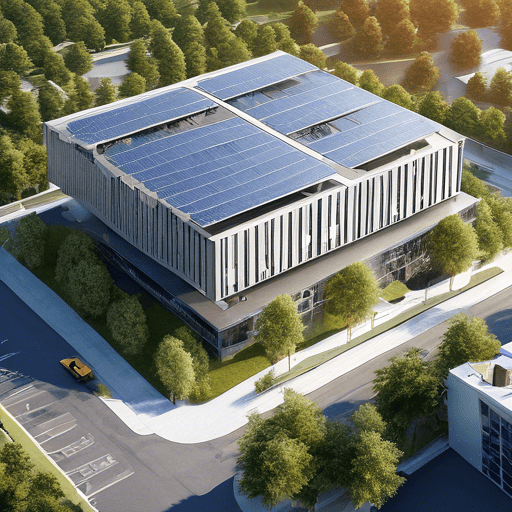Introduction Restaurants use about 2X more energy per sq. ft. than most commercial buildings out there. And most of that

According to the International Energy Agency , construction and buildings are responsible for about 15% of annual global C02 emissions. In addition, space heating uses around 25 percent of the total energy used in commercial buildings. Therefore, it’s important to reduce the impact multifamily and commercial buildings have on the environment by moving to net zero goals. This can be achieved by retrofitting existing commercial buildings and building new structures to a net zero standard.
However, if your commercial building cannot reach net zero energy, there are some steps you can take to increase its energy efficiency and move closer to a more sustainable feature.
What is a net-zero commercial building?
An NZE commercial building refers to a structure whose total annual energy consumption is equivalent to the amount of renewable energy generated on-site. This helps to reduce the amount of greenhouse gas emissions released into the atmosphere to minimize the impact on the environment.
There are various ways to achieve a net-zero commercial building. For instance, MEP for commercial buildings can include high-efficiency HVAC systems, operation equipment, and lighting systems, sealing the building envelope, and connecting the building to a renewable energy system.
In addition, NZE commercial buildings lead to significant energy savings in the long run, thus offsetting the extra upfront costs used to build the structure to those standards.
How commercial buildings can achieve Net Zero goals
The first step to moving commercial buildings towards net-zero goals is to exercise energy-efficient strategies during the renovation of existing buildings and the construction of new structures. For instance, you may use on-site energy sources to minimize the reliance on fossil fuels.
Traditionally, commercial buildings used natural gas and electricity to meet their energy needs, with most structures having individual HVAC systems. When many commercial buildings are located close together, a central heating & cooling plant can be used to distribute chilled water, steam, and hot water to multiple buildings.
Theoretically, a net zero commercial building should generate as much energy as it uses every year, although not many buildings can meet that goal at the moment. However, due to renewable energy systems and technological advancement, Net zero goals are becoming a more common reality for commercial buildings.
In general, Net zero energy for commercial buildings can be classified into 4 different components. That is; Net Zero Energy Emissions, Net Zero Site Energy, Net Zero Energy Costs, and Net Zero Source Energy.
To achieve net zero energy emissions, a building should use energy that doesn’t produce emissions, usually from an on-site renewable energy system.
Site energy refers to the energy generated and used at a building. Therefore, net zero site energy is achieved by generating all the building energy at the site and using it in the facility for over a year.
This is the easiest parameter to measure since a commercial building with net-zero energy costs has an annual energy bill of $0.
Source energy refers to the initial energy needed to supply power to the site, including the energy lost during distribution, transmission, and generation.
Grid connection and Net Zero commercial buildings
Most net zero energy commercial buildings are usually connected to the grid. Therefore, electricity generated from other sources like natural gas can be used when renewable energy produced on-site doesn’t meet the building’s energy load. Similarly, when excess energy is produced on-site, it can be exported back to the electric grid.
Commercial buildings can achieve net zero goals through energy-efficient design, which can be created using the following options;
How to generate renewable energy for Net Zero Commercial Buildings
The Net Zero Energy CBI (Commercial Building Initiative)
Governments are also encouraging commercial buildings to move toward the Net zero goals. For instance, the Net Zero Energy CBI is looking to construct NZE buildings by 2025 using public & private partnerships. Commercial buildings can make these changes through various strategies such as;
Energy modeling and simulation can be done through suitable simulation software. The software analyzes the energy model of the building and calculates energy consumption quantities. In addition, it helps you choose the ideal energy-efficient design strategy to use such as renewable energy systems, efficient HVAC systems, and passive design strategies.
Building facades for areas with hot climates like California can use shaded walls, reflective glazing, passive cooling, double glazing, insulation, and light exterior colors. On the other hand, facades in cold climates can use daylighting, passive solar heating, double insulation, and insulation. In addition, green roofs improve green space and air quality, reduce energy consumption and retain water. While double roofing reduces or eliminates heat build-up between the roof and the structure, thus reducing the indoor temperature.
HVAC systems for Net Zero commercial buildings can include biomass to be more eco-friendly and cost-effective. Moreover, incorporating wireless temperature monitoring technology in the building’s HVAC system will change the temperatures according to the activities and occupancy.
Conclusion
Overall, energy modeling and simulation will help you plan, calculate and visualize various MEP design considerations for Net Zero commercial buildings. These factors can include HVAC & lighting systems, building envelope improvements, occupancy loads, material selection, and the use of renewable energy sources. Hiring the right MEP design services from a reputable design and engineering firm like Innodez will help your commercial building move towards net zero goals successfully!
About Author
InnoDez